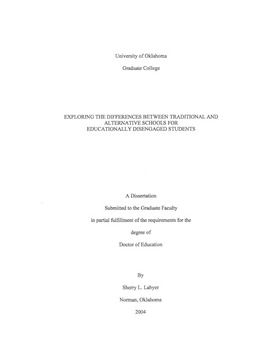| dc.contributor.advisor | Garn, Gregg, | en_US |
| dc.contributor.author | Labyer, Sherry L. | en_US |
| dc.date.accessioned | 2013-08-16T12:19:23Z | |
| dc.date.available | 2013-08-16T12:19:23Z | |
| dc.date.issued | 2004 | en_US |
| dc.identifier.uri | https://hdl.handle.net/11244/719 | |
| dc.description.abstract | The intent of both programs is to intervene with students whose academic and social behaviors are indicators of at-risk characteristics for not graduating from high school. The E.D.G.E. and F.A.M.E. Academies are both schools of choice and the decision to attend school is solely the students' decision. | en_US |
| dc.description.abstract | This descriptive case study investigated two alternative education academies designed to serve at-risk students for grades six through twelve. Both alternative academies are located in rural towns in Southwest Oklahoma. One program is a cooperative effort of blended students from five high schools and the other program is an extension of the local high school. The largest alternative academy in the case study has an enrollment of 107 students and the smallest alternative academy has an enrollment of 43 students. Both programs have been perceived successful as an intervention for at-risk students, that have dropped out of high school or are potential dropouts. | en_US |
| dc.description.abstract | Research was conducted at both academies during site visits and onsite observations. Data were gathered using three qualitative methods. On-site observation provided the researcher a first-hand lived experience as an insider. Document examination produced contextual information regarding a historical description of the programs and successful interventions for at-risk students. Focused, open-ended interviews with staff revealed descriptive information on how they help students be successful in alternative school and reasons they are not in traditional school. Surveys conducted with students classified, as sophomores through seniors were a source of quantitative data that enhanced and enriched the case study. | en_US |
| dc.description.abstract | Both academies have adopted acronyms for names of their schools. The largest academy is named The E. D. G. E. Academy (Environment Designed to Gain an Education) and the smaller academy is named The F.A.M.E. Academy (Facilitating Alternative Methods in Education). Each academy provides a self-paced, ability level and individualized instructional environment that fosters success. Both programs employ a strong counseling component that provides a combination of academic, group, individual and art therapy counseling. | en_US |
| dc.description.abstract | Information was recorded, transcribed and analyzed for emerging and recurring themes related to the existence and success of both programs. Data revealed that at-risk students come to the academies with negative labels from home, their traditional school or both. It is the researcher's endeavor to drop the negative label of at-risk students and refer to these students as educationally disengaged. | en_US |
| dc.format.extent | xii, 186 leaves ; | en_US |
| dc.subject | Alternative education Oklahoma. | en_US |
| dc.subject | Problem youth Education Oklahoma. | en_US |
| dc.subject | Alternative education Case studies. | en_US |
| dc.subject | Education, Administration. | en_US |
| dc.subject | Alternative schools Oklahoma. | en_US |
| dc.subject | Problem youth Education Case studies. | en_US |
| dc.title | Exploring the differences between traditional and alternative schools for educationally disengaged students. | en_US |
| dc.type | Thesis | en_US |
| dc.thesis.degree | Ed.D. | en_US |
| dc.thesis.degreeDiscipline | Department of Educational Leadership and Policy Studies | en_US |
| dc.note | Source: Dissertation Abstracts International, Volume: 65-02, Section: A, page: 0367. | en_US |
| dc.note | Major Professor: Gregg Garn. | en_US |
| ou.identifier | (UMI)AAI3122303 | en_US |
| ou.group | Jeannine Rainbolt College of Education::Department of Educational Leadership and Policy Studies | |
